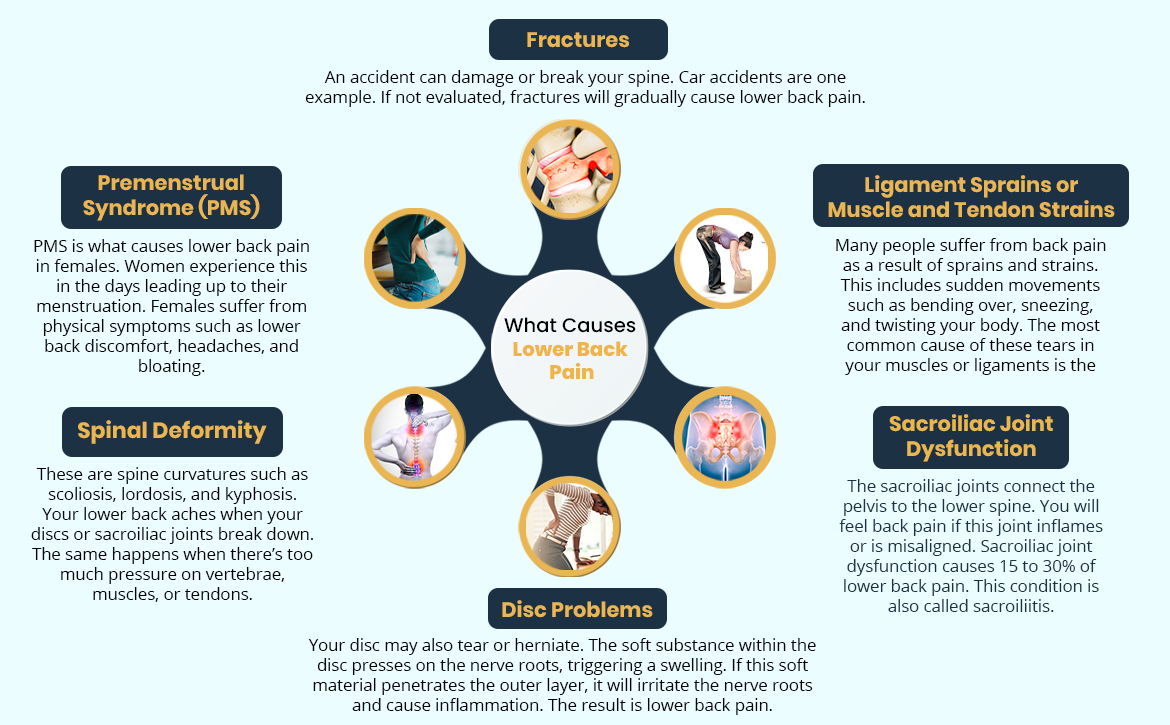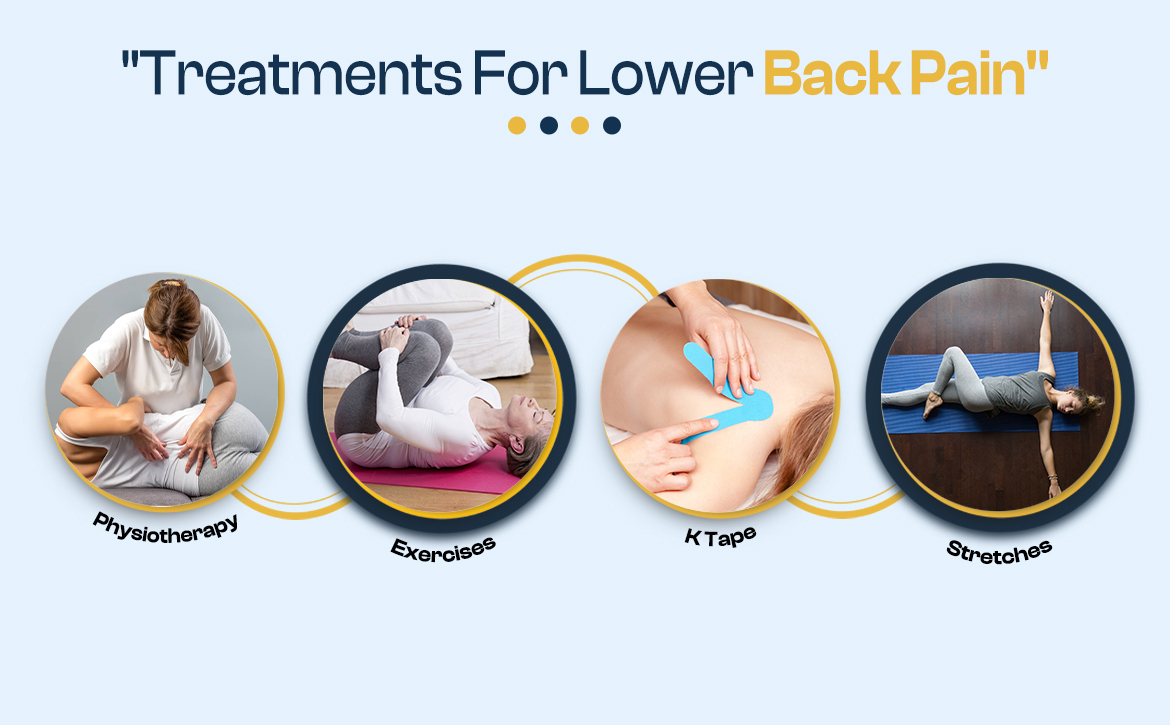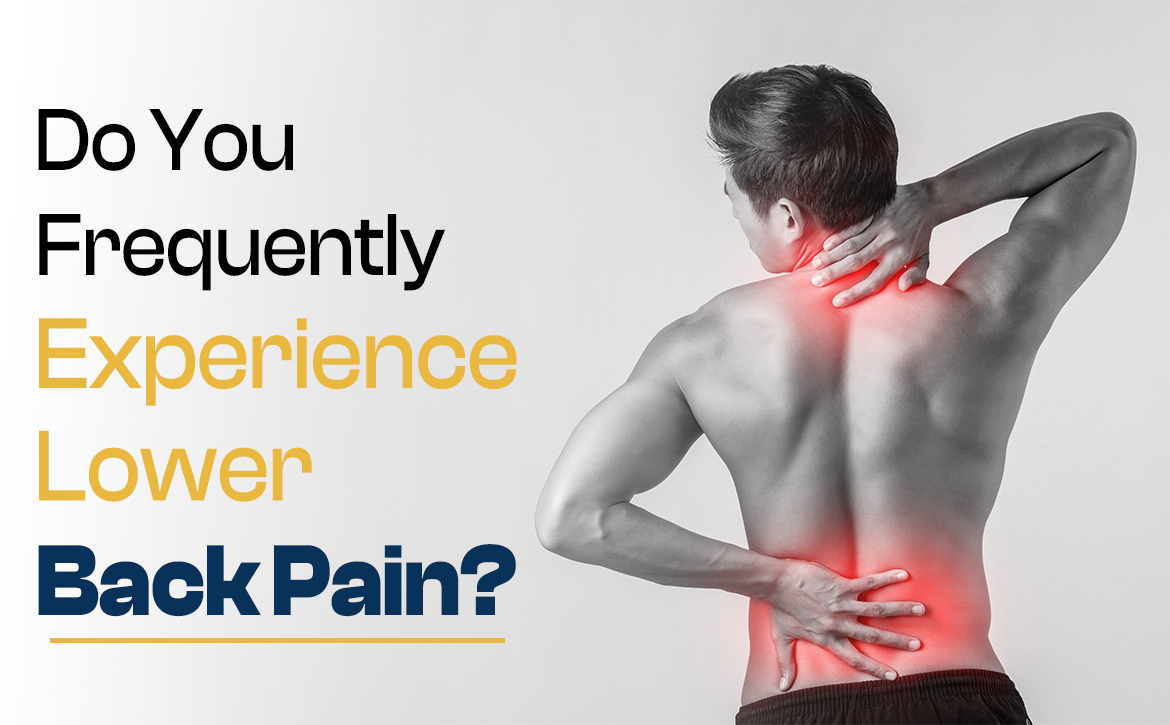Almost every reason an employee misses work is due to lower back pain. Such a condition is common and inconvenient. This is hardly surprising given that 80% of the world’s population suffers from lower back aches.
Most conditions are minor, and you can treat them at home. They mostly need rest or a little stretching for the pain to go away. Meanwhile, others are recurring or chronic and need medication or some serious medical attention. Severe lower back pain when walking or standing has more serious underlying causes.
If you experience back pain frequently, you’re almost certainly curious about how to treat it. Read through this blog to find out more about these treatments. But to better understand them, we first need to dive into the causes of lower back pain.
What Causes Lower Back Pain
A variety of reasons can cause lower back pain. Some were caused by injuries, while others had underlying causes. The following are a few of its more common causes:

Ligament Sprains or Muscle and Tendon Strains
Many people suf
fer from back pain as a result of sprains and strains. This includes sudden movements such as bending over, sneezing, and twisting your body. The most common cause of these tears in your muscle
s or ligaments is the improper or excessive lifting of heavy objects.
Disc Problems
Many things can happen in your intervertebral discs, resulting in lower back pain. Your disc wall thins and weakens as you age. It no longer serves as a cushion for your spinal column.
Your disc may also tear or herniate. The soft substance within the disc presses on the nerve roots, triggering a swelling. If this soft material penetrates the outer layer, it will irritate the nerve roots and cause inflammation. The result is lower back pain.
Sacroiliac Joint Dysfunction
The sacroiliac joints connect the pelvis to the lower spine. You will feel back pain if this joint inflames or is misaligned. Sacroiliac joint dysfunction causes 15 to 30% of lower back pain. This condition is also called sacroiliitis.
Spinal Deformity
These are spine curvatures such as scoliosis, lordosis, and kyphosis. Your lower back aches when your discs or sacroiliac joints break down. The same happens when there’s too much pressure on vertebrae, muscles, or tendons.
Fractures
An accident can damage or break your spine. Car accidents are one example. If not evaluated, fractures will gradually cause lower back pain.
Premenstrual Syndrome (PMS)
PMS is what causes lower back pain in females. Women experience this in the days leading up to their menstruation.
You may think women only experience sudden cravings and mood swings during this period. However, they also suffer physical symptoms such as lower back discomfort, headaches, and bloating. They also have more active anxiety, which is why women sometimes don’t act themselves during PMS. It’s not them, but the physical and emotional symptoms associated with PMS.
Aside from sudden lower back pain in a female caused by PMS, conditions such as arthritis, osteoporosis, facet joint dysfunction, spinal stenosis, compression fractures, infection, tumours, and others can also cause back discomfort or pain.
Treatments for Lower Back Pain

Treatments for lower back pain differ depending on its severity. Chronic ones necessitate proper diagnosis and medical treatment. Most lower back pain doesn’t require a scan or diagnosis, and you can use home remedies.
For minor or simple back pains, you may try these treatments at home:
K Tape for Lower Back Pain
Kinesiology tapes aren’t just for athletes. Even ordinary people can benefit from the pain relief that K tape provides. K tape for lower back pain is when you apply kinesiology tape near your spine to manage pain, stiffness, and discomfort.
Specific K-taping and strapping techniques provide pain relief and adequate spinal support. This allows you to move around as the K tape works to relieve your discomfort.
Physiotherapy
Physiotherapy treatments are effective for the majority of lower back pains. Research backs this up, proving the treatment’s effectiveness. Mobility exercises are part of lower back pain physiotherapy.This treatment also includes massage and joint mobilization, known as manual therapy.
Resting
Most lower back pains are triggered by excessive movements or wear and tear. Hence, sufficient rest would assist in alleviating the pain. You can also relax your muscles with a warm bath. While resting, you can put an ice pack on your back to reduce swelling.
However, keep the resting period brief, since too much rest may interfere with your healing process. Remember that proper movement is required to heal your back.
Exercise and Stretches
Lower back exercises are practical for both preventing and treating lower back pain. They strengthen your bones and muscles. It also improves your posture. Try doing core or abdominal muscle exercises such as superman, leg raises, and partial curls to support your spine better. Walking may be a low-impact exercise, but it’s effective in easing lower back pain.
Before these exercises, professionals advise doing lower back stretches for 20 to 30 seconds. The knees-to-chest pose and the traditional child’s pose mainly target back discomfort. Along with this, you should also maintain a healthy body weight and lead a healthy lifestyle. You should at least quit smoking, as nicotine damages your disc.
Meanwhile, more than simple stretches and rest will be required if you’re experiencing chronic lower back pain. If this is your case, here’s what you can do:
Consult a Doctor
Severe back pain necessitates a visit to the doctor. Don’t take this for granted or rely solely on some stretching for lower back pain. As mentioned above, some lower back pains have underlying causes. You must undergo tests and receive a proper diagnosis from a licenced medical professional.
They will give you the medications necessary for your lower back pain case. You will likely receive customised treatment plans. They may recommend surgery such as discectomy, nucleoplasty, or spinal fusion for severe cases.
Most severe back pains are normal, and you can treat them at home. However, if your back pain persists after trying home remedies, visiting your doctor is the safest way how to relieve severe lower back pain.
Conclusion
Lower back pain in men and women is a common ailment. The chance of suffering from this pressure in the lower back increases with age. Being overweight and maintaining an unhealthy lifestyle are also risk factors for developing this condition. You will also experience lower backache if you continue to have poor posture.
Other causes that may result in enduring lower back pain include muscle and tendon sprains and strains, sacroiliac joint dysfunction, fractures, spinal deformity, disc problems, and more. Some of these causes are visible, while others are underlying and require medical professionals and tests to determine.
There are several ways to treat lower back pain at home. Some pains go away after taking a short rest. You may also practise stretching and exercise to strengthen your muscles. This will support your back or spine. Physiotherapy can also help you get rid of the pain.Physical therapy may also help, especially with sacroiliac joint pain.
Most people prefer kinesiology tapes to help them manage lower back pain. These tapes don’t restrict their movements; they need to move around to heal their backs faster. Most importantly, K tapes are proven to relieve pain and eliminate discomfort.
You can manage normal lower back pain with all these remedies. However, when all has been done and the pain remains severe, there goes the answer to your question, “When should I be worried about lower back pain?” Visit your doctor right away and consult for the best possible treatment.

